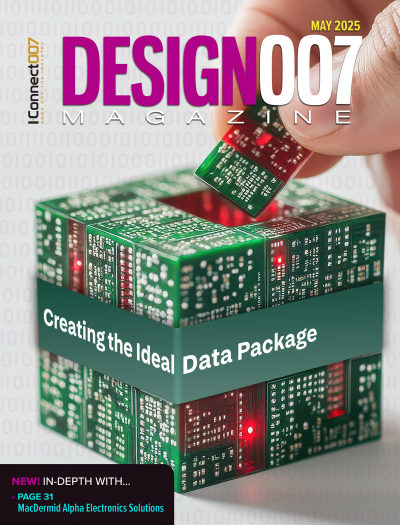-

- News
- Books
Featured Books
- design007 Magazine
Latest Issues
Current Issue
Showing Some Constraint
A strong design constraint strategy carefully balances a wide range of electrical and manufacturing trade-offs. This month, we explore the key requirements, common challenges, and best practices behind building an effective constraint strategy.

All About That Route
Most designers favor manual routing, but today's interactive autorouters may be changing designers' minds by allowing users more direct control. In this issue, our expert contributors discuss a variety of manual and autorouting strategies.

Creating the Ideal Data Package
Why is it so difficult to create the ideal data package? Many of these simple errors can be alleviated by paying attention to detail—and knowing what issues to look out for. So, this month, our experts weigh in on the best practices for creating the ideal design data package for your design.
- Articles
- Columns
- Links
- Media kit
||| MENU - design007 Magazine
Duality AI Contracts with NASA JPL for Phase II of DARPA RACER Program
September 13, 2024 | BUSINESS WIREEstimated reading time: 2 minutes
Duality AI, the company behind Falcon, a digital twin simulation platform, today announced an agreement with NASA’s Jet Propulsion Laboratory (NASA JPL) in Pasadena to continue its work on Defense Advanced Research Projects Agency’s (DARPA’s) Robotic Autonomy in Complex Environments with Resiliency program (RACER). This announcement follows Phase I of the RACER project, where Duality successfully completed the program, as one of only two simulation providers selected by DARPA. The agreement accelerates autonomy development for NASA JPL by allowing rapid iteration and discovery of flaws through simulation, reducing risks and providing the synthetic data vital to training advanced AI algorithms that push the boundaries of robotic autonomy.
During the second phase of the RACER program, teams will have to display their ability to create advanced AI solutions that allow large-scale vehicles to travel autonomously at faster speeds and over longer distances than in Phase 1. The team from NASA JPL will use Duality’s advanced digital twin simulator, Falcon, to overcome the challenges associated with autonomous high-speed, off-road vehicles, including mapping, perception, planning, and responding to hazards and obstacles. The ultra-realistic synthetic data generated by Falcon is pivotal in the training and testing of the next-generation AI systems.
"Success in the RACER program relies on training intelligent systems to complete complex tasks that traditional autonomous vehicles do not face. From unexpected obstacles to unpredictable weather challenges, the number of scenarios these AI systems must be trained and tested against is astounding,” said Mike Taylor, Chief Product Officer and co-founder of Duality AI. "Simulation technology enables a practical way for NASA JPL to train their systems in virtual environments and generate synthetic data that is essential for highly-capable AI models to be ready for any challenge.”
As part of the agreement, Duality will provide the tools and processes required to train AI through the use of digital twin simulation and aid in the development of NASA JPL's next generation of autonomy technologies. The contract also provides NASA JPL with access to expansive, highly realistic digital twin environments necessary for robust testing and training of autonomy software. The digital twins of real locations enable the NASA JPL team to generate relevant synthetic data and test their autonomy software with a higher percentage of code coverage than possible with conventional simulators. By leveraging Duality's AI-powered tools to build digital twin environments from satellite imagery, as well their library of configurable virtual sensors, NASA JPL can easily manipulate digital twin environments with different rocks, trees, weather, and more. This level of precise control helps NASA JPL transition cutting-edge ideas from simulation into the real world.
Duality’s contract with NASA JPL advances Duality’s mission to build a digital twin simulation platform that helps solve the most complex robotics problems. Working alongside top minds in robotics allows Duality to enhance its simulation capabilities and demonstrate the power of its technology by overcoming immense real-world challenges.
Testimonial
"The I-Connect007 team is outstanding—kind, responsive, and a true marketing partner. Their design team created fresh, eye-catching ads, and their editorial support polished our content to let our brand shine. Thank you all! "
Sweeney Ng - CEE PCBSuggested Items
NASA to Preview Advanced US-India Radar Mission Ahead of Launch
07/17/2025 | NASA JPLThe NISAR satellite, a collaboration between NASA and the Indian Space Research Organisation, will provide a three-dimensional view of Earth in unprecedented detail.
NASA Selects Instruments for Artemis Lunar Terrain Vehicle
07/14/2025 | NASA JPLThe JPL-led UCIS-Moon imaging spectrometer will map the Moon’s geology, water, and ice, from orbit, measuring how human activity affects those volatiles.
NASA, German Aerospace Center to Expand Artemis Campaign Cooperation
06/24/2025 | NASAWhile attending the Paris Air Show June 16, NASA acting Administrator Janet Petro signed an agreement with DLR (German Aerospace Center, or Deutsches Zentrum für Luft- und Raumfahrt) to continue a partnership in space medicine research.
Yank Technologies Selected for Prestigious NASA Phase II Contract for Dust-Tolerant Resonant Connectors
05/20/2025 | PRNewswireYank Technologies, the developer of disruptive long range, high power wireless charging solutions, has been selected for a two-year follow-on Small Business Innovation Research (SBIR) Phase II contract from the National Aeronautics and Space Administration (NASA) to advance Dust-Tolerant Resonant Connectors for lunar and planetary surfaces.
Proposed NASA Budget Redirects Funding Toward Mars, Ends Key Programs
05/06/2025 | I-Connect007 Editorial TeamThe Trump administration has proposed a $6 billion reduction to NASA’s budget for FY 2026, with $1 billion redirected toward Mars-focused programs. According to a discretionary budget document published on NASA’s website, the plan shifts resources toward returning to the Moon ahead of China and initiating a human mission to Mars.


